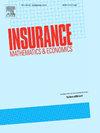Approximations of multi-period liability values by simple formulas
IF 2.2
2区 经济学
Q2 ECONOMICS
引用次数: 0
Abstract
This paper is motivated by computational challenges arising in multi-period valuation in insurance. Aggregate insurance liability cashflows typically correspond to stochastic payments several years into the future. However, insurance regulation requires that capital requirements are computed for a one-year horizon, by considering cashflows during the year and end-of-year liability values. This implies that liability values must be computed recursively, backwards in time, starting from the year of the most distant liability payments. Solving such backward recursions with paper and pen is rarely possible, and numerical solutions give rise to major computational challenges.
The aim of this paper is to provide explicit and easily computable expressions for multi-period valuations that appear as limit objects for a sequence of multi-period models that converge in terms of conditional weak convergence. Such convergence appears naturally if we consider large insurance portfolios such that the liability cashflows, appropriately centered and scaled, converge weakly as the size of the portfolio tends to infinity.
用简单公式近似计算多期负债值
本文的动机是在保险的多期估值中出现的计算挑战。总保险负债现金流通常对应于未来几年的随机支付。然而,保险法规要求,通过考虑年度现金流量和年末负债值,以一年为期限计算资本要求。这意味着负债价值必须递归地计算,从最遥远的负债支付年份开始。用纸和笔来解决这种反向递归几乎是不可能的,而数值解决方案会带来重大的计算挑战。本文的目的是为以条件弱收敛为收敛条件的多周期模型序列的极限对象的多周期估值提供明确且易于计算的表达式。如果我们考虑大型保险投资组合,那么当投资组合的规模趋于无穷大时,负债现金流(适当地集中和缩放)弱收敛就会出现这种收敛。
本文章由计算机程序翻译,如有差异,请以英文原文为准。
求助全文
约1分钟内获得全文
求助全文
来源期刊

Insurance Mathematics & Economics
管理科学-数学跨学科应用
CiteScore
3.40
自引率
15.80%
发文量
90
审稿时长
17.3 weeks
期刊介绍:
Insurance: Mathematics and Economics publishes leading research spanning all fields of actuarial science research. It appears six times per year and is the largest journal in actuarial science research around the world.
Insurance: Mathematics and Economics is an international academic journal that aims to strengthen the communication between individuals and groups who develop and apply research results in actuarial science. The journal feels a particular obligation to facilitate closer cooperation between those who conduct research in insurance mathematics and quantitative insurance economics, and practicing actuaries who are interested in the implementation of the results. To this purpose, Insurance: Mathematics and Economics publishes high-quality articles of broad international interest, concerned with either the theory of insurance mathematics and quantitative insurance economics or the inventive application of it, including empirical or experimental results. Articles that combine several of these aspects are particularly considered.
 求助内容:
求助内容: 应助结果提醒方式:
应助结果提醒方式:


